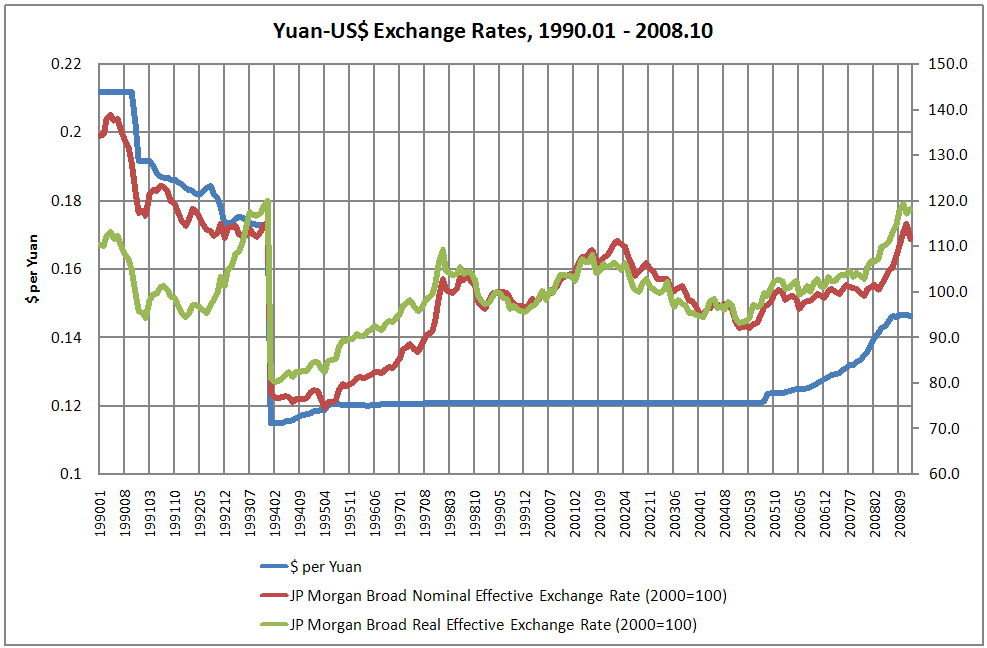In defense of China, the responsibility for the financial crisis does not lie with China. Meanwhile, the very people who caused the financial crisis are being appointed by Obama to decide how to respond to it.
When all else fails, blame China
Courtesy of Willem Buiter, writing in the Financial Times, at Willem’s ft.com/maverecon blog.

The threat to world trade comes from the Omnibus Trade and Competitiveness Act of 1988. The section dealing with the exchange rate, bilateral current account balances and the overall current account balance is a monument to economic illiteracy.
Under the Omnibus Trade and Competitiveness Act of 1988, “The Secretary of the Treasury shall analyze on an annual basis the exchange rate policies of foreign countries, in consultation with the International Monetary Fund, and consider whether countries manipulate the rate of exchange between their currency and the United States dollar for purposes of preventing effective balance of payments adjustments or gaining unfair competitive advantage in international trade.”
“If the Secretary considers that such manipulation is occurring with respect to countries that (1) have material global current account surpluses; and (2) have significant bilateral trade surpluses with the United States, the Secretary of the Treasury shall take action to initiate negotiations with such foreign countries on an expedited basis, in the International Monetary Fund or bilaterally, for the purpose of ensuring that such countries regularly and promptly adjust the rate of exchange between their currencies and the United States dollar to permit effective balance of payments adjustments and to eliminate the unfair advantage.”
Should the US Treasury officially determine China to be a currency manipulator, the US Administration can unleash a range of remedies, including antidumping measures, countervailing duties, and safeguards. Although the World Trade Organization permits certain retaliatory responses from importing nations which can prove that they suffered material injury due to unfair trade practices, much of what the US Congress and some members of the Obama administration have in mind is likely to be in clear violation of the United States’ WTO obligations. It would certainly provoke a response from China. The bilateral trade war that is likely to result could easily spread to the EU, Japan and emerging markets outside China.
Overall and bilateral current account imbalances and nominal and real, bilateral and effective exchange rates
The overall current account deficit of the US is the excess of US domestic investment over US national saving. The overall current account surplus of China is the excess of China’s national saving over China’s domestic investment. Bilateral trade balances are of no economic interest, unless there are only two countries in the world. Note that the first quote from the Omnibus Trade and Competitiveness Act of 1988 slides seamlessly from overall current account imbalances to bilateral trade imbalances, ignoring the transfer payments and foreign investment income items that are included in the current account but not in the trade balance. Trade balances and current account balances (bilateral or aggregate) can and do move in opposite directions.
There is no reason in economic theory or empirical fact why there should be any reliable correlation, between nominal exchange rates (bilateral or trade-weighted (effective) ) and the bilateral or aggregage trade balance, let alone a clear causal connection from any nominal exchange rate to the trade balance. Certain kinds of shocks and policy actions may produce an empirical association (not a causal relation) between a depreciation of the effective (trade-weighted) real exchange rate and an increase in the aggregate trade surplus. This is the case, for instance, for most aggregate demand shocks, e.g those produced by contractionary Keynesian fiscal policies. But supply shocks may produce the opposite correlation, that is, a depreciation of the effective real exchange rate and a reduction in the aggregate trade balance surplus.
In any case, as Chart 1 below shows, there has been a steady appreciation of the real effective exchange rate of the Yuan since the beginning of 2005. JP Morgan’s broad real effective exchange rate index for the Yuan shows a 27 percent real appreciation since December 2004. The from a macroeconomic perspective uninteresting nominal bilateral US$-Yuan exchange rate appreciated 21 percent over the same period.
Chart 1
Every fixed or managed nominal exchange rate is, by definition, ‘manipulated’. But only the most bone-headed of ultra-Keynesians believes that a country can influence its effective real exchange rate in a lasting manner by managing/manipulating its effective nominal exchange rate, let alone some bilateral nominal exchange rate. China is now enough of a market economy that its domestic prices and costs (in Yuan) are no longer controlled by the Chinese authorities. Instead they are driven by the same kind of monetary and other macroeconomic forces that drive US dollar prices and costs in the USA.
China still controls its capital account to a significant extent. Judging from the havoc created by wide-open capital accounts in other emerging markets, the Chinese decision to liberalise its capital account gradually and slowly is a wise one. Most gross external investment by Chinese residents is done by the state. With capital inflows (mainly in the form of FDI) policy controlled, the large current account surplus of China has meant a massive increase in the external assets of the state. The state has, unwisely, allocated most of the task of managing its foreign assets to the central bank, which has been a terrible foreign investor. By choosing to invest well over a trillion US dollar’s worth of foreign assets in US Treasury bills, the Chines central bank has produced horrible real returns for the Chinese government and the Chinese people, and made a large capital gift to the US government and the US people. The returns on Chinese foreign investment through its sovereign wealth fund have not been any better of course.  Like the Japanese before them, great manufacturers and exporters often turn out to be terrible portfolio investors, even when their own FDI investments abroad have done well.
Like the Japanese before them, great manufacturers and exporters often turn out to be terrible portfolio investors, even when their own FDI investments abroad have done well.
The accumulation of China’s external assets in the accounts of the Chinese central banks shows up statistically as an increase in official foreign exchange reserves. The Chinese authorities have been unable to sterilise this massive increase in reserves and China has seen rates of domestic cost and price inflation that have at times been uncomfortably high. This is the normal way in which management/manipulation of the nominal exchange rate fails to prevent the changes in the real exchange rate warranted by fundamentals. China is enough of a market economy that it cannot manipulate its real effective exchange rate.
There are indeed global macroeconomic imbalances. The US saves too little or invests too much (I would argue the former) and has an unsustainable current account deficit. China saves too much or invests too little (I would argue the former) and has an unsustainable current account surplus. China is taking policy measures that will reduce its external surplus, mainly through expansionary fiscal policy measures aimed at boosting public sector investment (infrastructure) and at reducing private and corporate saving.
The US is proposing policy measures that will increase its external deficit. The $825bn fiscal stimulus over two years proposed by the Obama administration will increase the US current account deficit. It will also strengthen the real effective exchange rate of the US dollar, unless there is a loss of faith in the ability of the US sovereign to service its debt in the future through higher taxes or lower public spending. In that case the nominal exchange rate could decline sharply, taking the real exchange rate with it in the short run, as market participants dump the US dollar and US dollar-denominated securities because they fear either a monetisation of public debt and deficits or a sovereign default.
So China is undertaking actions to remedy its own external imbalances and global imbalances. The US is proposing measures to increase its external imbalances and aggravate global imbalances. Instead of saving more, the US government is desperately trying to get the already over-leveraged US consumer to save less. And just in case the US consumer balks at the fiscal carrots dangled in front of him, the already fiscally challenged US government is proposing to reduce its own saving and increase its own investment.
The last thing the US economy needs is a large fiscal stimulus, or indeed any fiscal stimulus at all. A good argument can even be made for a US fiscal tightening. Expansionary monetary policy is the only instrument available to the authorities that will both boost the US economy and correct its external imbalance. With the Federal Funds target rate as close to zero as makes no difference, only aggressive quantitative easing and qualitative easing (what Bernanke calls credit easing) are available and the magnitude and timing of their impact is uncertain. That’s tough, but that’s the way it is. The belief- the faith almost – that there has to be a painless way out of the US economic dilemma is naive and will be disproven by economic record of the coming years. The notion that currency manipulation by China is a material contributor to America’s external trade deficit is either a dangerous form of self-delusion, or an even more dangerous form of pandering to xenophobic Congressional opinion, or both.
Conclusion
One reason I still nurture the hope that the current global recession will not become a second Great Depression, is that there has been no significant recourse to trade restrictions by countries trying to export their domestic demand deficiencies to their neighbours. There has been increased use of anti-dumping measures – the first recourse of the modern protectionist, beggar-thy-neighbour scoundrel – but less than might have been expected given the prevailing spineless political leadership around the globe. As unemployment and excess capacity increase, and corporate bankruptcies multiply, the calls for protection against ‘unfair’ foreign competition will multiply.  Any excuse – environmental, social, labour standards, phyto-sanitary, national security – will be used to allow domestic industry and labour to find shelter from the storm. Old-style protectionists like Sarkozy find new converts such as Merkel, to push protectionist measures, including state aid for non-systemically important industries like automobile manufacturing.
Any excuse – environmental, social, labour standards, phyto-sanitary, national security – will be used to allow domestic industry and labour to find shelter from the storm. Old-style protectionists like Sarkozy find new converts such as Merkel, to push protectionist measures, including state aid for non-systemically important industries like automobile manufacturing.
So while the protectionist genie is not yet out of the bottle, it is kicking and pushing against the cork, trying to escape. The verbal sabre rattling by US Treasury Secretary Geithner is a threat to the open global trading system. More stupidities along the same lines could bring us the global trade conflict that we have been fortunate to avoid thus far.




